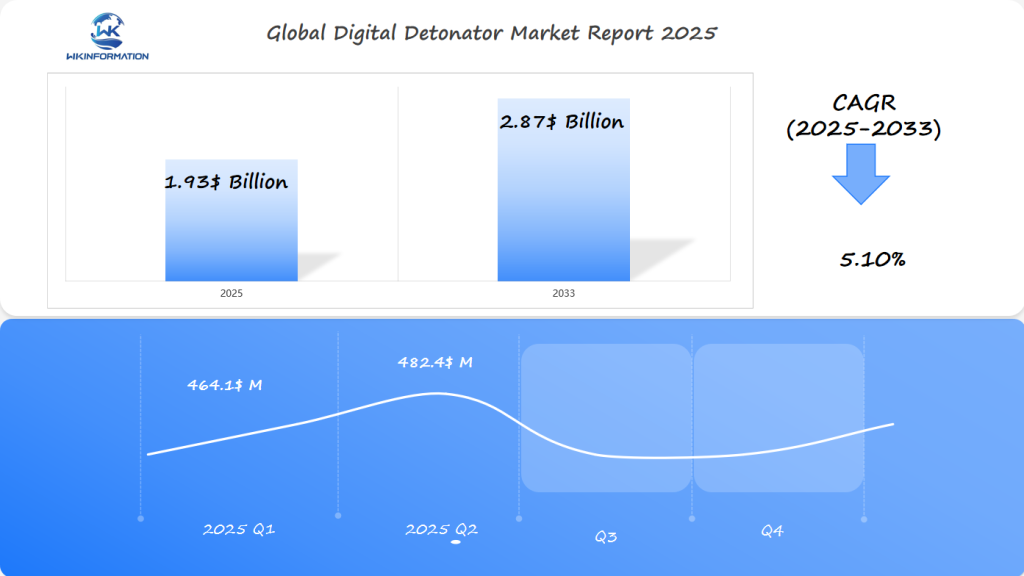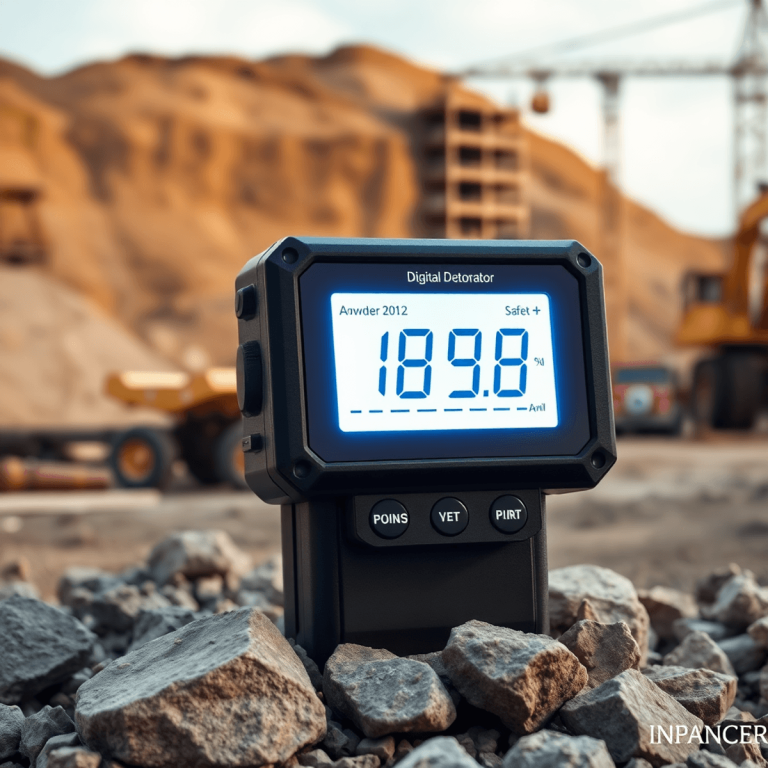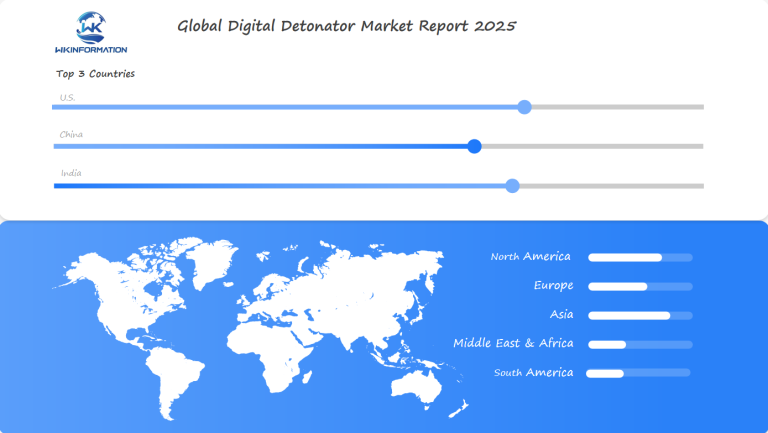$1.93 Billion Digital Detonator Market Set to Explode in the U.S., China, and India by 2025
Explore the digital detonator market’s growth trends, key drivers, and forecasts, highlighting its role in mining, construction, and global infrastructure projects.
- Last Updated:
Projected Market Insights for Digital Detonator in Q1 and Q2 of 2025
The Digital Detonator market is projected to reach $1.93 billion in 2025, with a CAGR of 5.10% from 2025 to 2033. In Q1, the market is expected to generate around $464.1 million, driven by rising demand in mining, construction, and military applications. By Q2, the market is anticipated to reach approximately $482.4 million, as advancements in precision blasting and automation technology gain momentum.
The U.S., China, and India are expected to be the leading markets. The U.S. drives growth with its technological advancements in defense and infrastructure, China’s booming construction sector fuels demand, and India’s expanding mining industry contributes significantly to market expansion. As industries move toward safer and more efficient blasting techniques, digital detonators will continue to see strong adoption globally.

Understanding the Upstream and Downstream Industry Chains in the Digital Detonator Market
Understanding the upstream and downstream industry chains is crucial in the digital detonator market.
Upstream Activities
Upstream activities involve raw material extraction and technology development, focusing on sourcing materials like explosives, circuitry, and sensors essential for creating high-precision detonators. The innovation at this stage often dictates the quality and reliability of the final product.
Downstream Processes
Downstream processes involve distribution, sales, and after-market services, making sure that digital detonators are delivered to end-users effectively. This includes managing logistics, creating marketing strategies, and setting up customer support systems to preserve product quality and keep users happy.
Key players in supply chain management are crucial to this process:
- Manufacturers such as Orica Limited and Dyno Nobel play a significant role in transforming raw materials into advanced digital detonators.
- Logistics providers ensure timely delivery of products to markets across the U.S., China, India, and other regions.
- Distributors including regional specialists who understand local market demands aid in optimizing market reach.
These stakeholders work together to improve market efficiency by reducing delays and increasing product availability. Their roles are essential in adapting to changing market needs while keeping prices competitive.
Key Trends Reshaping the Digital Detonator Market Landscape
The digital detonator market is undergoing a significant transformation, largely fueled by technological advancements that are setting new standards in accuracy and safety. A primary driver of this growth is the increasing demand for accuracy and safety in explosive initiation systems. Industries such as mining and construction are increasingly seeking solutions that reduce risks and improve operational efficiency.
Shift Towards Electronic Detonators
One notable trend is the shift towards electronic detonators. These devices are rapidly replacing traditional options due to their superior performance characteristics. Electronic detonators offer enhanced safety features, including reduced ground vibration and better control over blast timing, which leads to improved fragmentation and minimized environmental impact.
Adoption of Electronic Detonators
Innovations such as advanced microchip technology have further propelled the adoption of electronic detonators, allowing for intricate control over detonation sequences. This precision not only optimizes resource extraction but also significantly lowers the likelihood of accidents, positioning electronic detonators as a preferred choice across various sectors.
As the industry continues to evolve, these trends highlight the importance of embracing advanced technologies to maintain competitiveness and meet rising safety standards.
Challenges in the Development and Regulation of Digital Detonators
The Digital Detonator Market faces a complicated set of rules that greatly affects its growth. Regulatory issues are critical as manufacturers work hard to meet strict standards set by different national and international organizations. Following these rules is vital for ensuring the safety and dependability of digital detonators, which are used in sensitive areas like mining and construction.
Manufacturers have several challenges to overcome:
- Certification Requirements: Getting certifications can take a lot of time and money. These certifications are needed to prove that products meet safety and performance standards.
- Environmental Regulations: Stricter environmental laws require that products have less impact on the environment, which affects how they are designed and made.
- Safety Standards: The need for better safety features means that technology has to keep improving, which raises research and development costs.
New companies wanting to enter the market face big obstacles because of these regulatory issues. High compliance costs and complicated certification processes can discourage startups and smaller businesses from taking advantage of the increasing demand for digital detonators.

Geopolitical Forces Shaping the Digital Detonator Market
Geopolitical factors play a crucial role in shaping the digital detonator market, particularly in sectors like oil and gas where these devices are extensively used. International relations can significantly influence market dynamics, especially when considering how geopolitical tensions or collaborations impact energy production and exploration activities.
Trade Policies Impacting Market Access
Trade policies are another critical element affecting market access. In North America, stringent import-export regulations and tariffs can either hinder or facilitate the entry of digital detonators into the market. The Asia Pacific region, driven by its rapid economic growth, presents both opportunities and challenges due to varying trade agreements and political climates among countries.
- North America: Trade policies here often emphasize environmental considerations and safety standards, affecting how digital detonators are manufactured and distributed.
- Asia Pacific: With diverse economies, trade policies vary widely, impacting market strategies for companies aiming to penetrate this expansive region.
Strategic Navigation in the Face of Geopolitical Forces
The interaction between geopolitical forces and market accessibility emphasizes the need for strategic navigation in the digital detonator industry. Companies must understand these dynamics to seize opportunities and manage risks in international trade.
As geopolitical situations change, key players will also adjust their strategies to stay relevant or expand their presence in this important market.
Market Segmentation: Types and Applications of Digital Detonators
To understand digital detonators better, we need to look at the different types available in the market. Each type has its own benefits and drawbacks. Let’s take a closer look:
Types of Digital Detonators
- Electric Detonators: Known for their simplicity and cost-effectiveness, these detonators are widely used due to their ability to deliver precise timing in explosive initiation. However, they are susceptible to accidental initiation from stray currents and electromagnetic fields.
- Electronic Detonators: Offering superior performance characteristics, electronic detonators provide enhanced precision and safety. Their programmability allows for intricate blast designs, reducing ground vibration and increasing efficiency. The downside is their higher cost compared to other types.
- Non-Electric Detonators: These are preferred for environments where electric interference might pose a risk. Using shock tubes rather than wiring, non-electric options offer reliability in challenging conditions but may lack the precision of electronic alternatives.
Applications of Digital Detonators
Digital detonators are used in various industries, including:
- Mining: They improve efficiency by allowing precise control over blasts, reducing damage to surrounding rock and increasing the amount of ore recovered.
- Construction: These detonators are used in demolition and site preparation work to ensure controlled explosions that protect nearby structures.
- Demolition: In urban areas, digital detonators offer the accuracy required to safely demolish buildings without causing damage to adjacent properties.
The wide range of applications for digital detonators highlights their importance in today’s industrial operations.
Digital Detonators in Mining: Enhancing Efficiency and Safety Standards
In the mining industry, digital detonators are crucial for improving both operational efficiency and safety compliance. These advanced devices enable precise timing and initiation of explosives, reducing ground vibration and optimizing fragmentation. This accuracy not only boosts performance but also greatly lowers the risk of accidents, ensuring adherence to strict safety regulations.
Operational Advantages:
- Precision Timing: Enables accurate control over blast sequences, leading to improved fragmentation.
- Safety Enhancement: Reduces misfires and enhances worker safety through reliable electronic systems.
- Cost Efficiency: Minimizes material waste and optimizes resource usage.
Case Studies:
- Australian Gold Mines: Implemented digital detonators that resulted in a 20% increase in ore recovery rates while maintaining safety protocols.
- South African Platinum Operations: Utilized these detonators to decrease blast-induced vibrations by 30%, reducing impact on surrounding infrastructure.
These examples highlight the tangible benefits of adopting digital detonators in mining operations, demonstrating their effectiveness in real-world scenarios. As the Digital Detonator Market continues to develop, innovations tailored to mining environments are expected to drive further advancements in safety and operational efficiency.
Global Insights into Digital Detonator Market Performance
Understanding how the digital detonator market is performing worldwide can help us see how it’s expected to grow. Wkinformation Research Firm has compared major markets like the United States, China, and India to identify specific trends in each country.

U.S. Market Growth in Digital Detonators
The U.S. market, known for its technological advancements, benefits from significant investments in energy sectors such as oil and gas. The demand for advanced perforating equipment, which uses digital detonators, continues to increase. This growth is supported by government initiatives and private sector investments aimed at improving production capabilities.
China’s Dominance in the Digital Detonator Sector
China’s digital detonator market is growing rapidly due to its fast-paced industrialization and urban development. The country’s focus on infrastructure projects and mining activities drives the need for more accurate and secure explosive initiation systems. With its ongoing economic growth, China remains an important player in the global scene.
India’s Increasing Demand for Digital Detonators
India’s market performance is primarily driven by economic growth and infrastructure development. The construction sector’s increasing requirements align with the rising use of digital detonators, which offer improved safety and efficiency. Additionally, India’s strategic focus on energy production contributes to steady market growth.
These insights show that different regions are experiencing their own unique paths of growth. They highlight how regional policies, technological advancements, and specific demands from various sectors are shaping the global market dynamics.
The Future Outlook: Opportunities Beyond Traditional Sectors
Digital detonators are set to transform industries beyond their usual roles in mining and construction. There’s a huge potential for future opportunities as these devices discover new applications in various areas.
1. Oil and Gas Exploration
Digital detonators can be used to improve safety and accuracy in hydraulic fracturing operations, resulting in more effective resource extraction.
2. Environmental Management
These devices could be useful in controlled demolitions for urban development projects, ensuring minimal harm to the environment through precise explosive control.
3. Defense Sector
The defense industry might gain from advanced digital detonators in situations requiring high precision and dependability, such as testing weapon systems or demolishing outdated military structures. This aligns with the ongoing national security technology regulation efforts that aim to enhance safety and efficiency in defense operations.
4. Space Exploration
As more space missions are being conducted, there is a potential for the implementation of digital detonators in spacecraft separation systems or the deployment of scientific instruments on the surfaces of planets.
5. Infrastructure Development
The growing focus on sustainable infrastructure presents opportunities for digital detonators to help construct complex structures with enhanced safety features.
Moreover, recent technological advancements are making way for more creative applications of digital detonators, further broadening their market potential.
These new applications demonstrate the adaptability of the digital detonator market, offering numerous prospects for expansion and innovation. As industries continue to evolve, so will the demand for these advanced devices, creating opportunities for broader uses.
Competitive Dynamics in the Digital Detonator Industry
Key players in the market:
- Yahua Group — China
- Poly Union Group — China
- Dyno Nobel — Australia
- Orica — Australia
- Huhua Group — China
- Schlumberger — USA/France
- NJSC NITROERG — Poland
- EPC Groupe — France
- Xinjiang Xuefeng — China
- Guotai Group — China
Overall
| Report Metric | Details |
|---|---|
| Report Name | Global Digital Detonatorr Market Report |
| Base Year | 2024 |
| Segment by Type |
|
| Segment by Application |
|
| Geographies Covered |
|
| Forecast units | USD million in value |
| Report coverage | Revenue and volume forecast, company share, competitive landscape, growth factors and trends |
The Digital Detonator Market is experiencing rapid growth driven by innovation. With technology advancing and customer demands changing, there is an increasing need for precise and safe explosive initiation systems.
Significant growth projections indicate that the market is expected to reach $1.93 billion by 2025. Key regions such as the U.S., China, and India are playing a crucial role in this expansion, supported by investments in industries like oil, gas, mining, and construction.
The shift from traditional detonators to electronic detonators demonstrates a preference for improved performance features. To navigate this ever-changing landscape, it is essential to embrace technological advancements and address regulatory challenges.
Industry leaders should prioritize enhancing their products and forming strategic partnerships to remain competitive. Ongoing innovation will not only fulfill current needs but also create new opportunities in emerging sectors.
The Digital Detonator Market is an industry that is ready for growth, with innovation leading the way.
Global Digital Detonator Market Report (Can Read by Free sample) – Table of Contents
Chapter 1: Digital Detonator Market Analysis Overview
- Competitive Forces Analysis (Porter’s Five Forces)
- Strategic Growth Assessment (Ansoff Matrix)
- Industry Value Chain Insights
- Regional Trends and Key Market Drivers
- Digital Detonator MarketSegmentation Overview
Chapter 2: Competitive Landscape
- Global Digital Detonatorplayers and Regional Insights
- Key Players and Market Share Analysis
- Sales Trends of Leading Companies
- Year-on-Year Performance Insights
- Competitive Strategies and Market Positioning
- Key Differentiators and Strategic Moves
Chapter 3: Digital Detonator Market Segmentation Analysis
- Key Data and Visual Insights
- Trends, Growth Rates, and Drivers
- Segment Dynamics and Insights
- Detailed Market Analysis by Segment
Chapter 4: Regional Market Performance
- Consumer Trends by Region
- Historical Data and Growth Forecasts
- Regional Growth Factors
- Economic, Demographic, and Technological Impacts
- Challenges and Opportunities in Key Regions
- Regional Trends and Market Shifts
- Key Cities and High-Demand Areas
Chapter 5: Digital Detonator Emerging and Untapped Markets
- Growth Potential in Secondary Regions
- Trends, Challenges, and Opportunities
Chapter 6: Product and Application Segmentation
- Product Types and Innovation Trends
- Application-Based Market Insights
Chapter 7: Digital Detonator Consumer Insights
- Demographics and Buying Behaviors
- Target Audience Profiles
Chapter 8: Key Findings and Recommendations
- Summary ofDigital Detonator Market Insights
- Actionable Recommendations for Stakeholders

Access the study in MULTIPLEFORMATS
Didn’t find what you’re looking for?
TALK TO OUR ANALYST TEAM
Need something within your budget?
NO WORRIES! WE GOT YOU COVERED!
Call us on: +1-866-739-3133
Email: infor@wkinformation.com
What is the projected growth of the digital detonator market by 2025?
The digital detonator market is projected to grow to $1.93 billion by 2025, driven by increasing demand across various sectors such as mining and construction.
Which regions are key drivers of growth in the digital detonator market?
The key regions driving growth in the digital detonator market are the U.S., China, and India. These countries have a high demand for advanced explosive initiation systems.
What are the main types of digital detonators available in the market?
The main types of digital detonators available include electric, electronic, and non-electric variants, each with their own advantages and limitations tailored to specific applications.
What challenges do manufacturers face in the development and regulation of digital detonators?
Manufacturers face regulatory challenges in meeting stringent standards set by authorities, which can impact market entry for new players looking to capitalize on growing demand.
How do geopolitical factors influence the digital detonator market?
Geopolitical factors have a significant impact on the digital detonator market. This is mainly through international relations that affect industries such as oil and gas, as well as trade policies that influence market access in North America and Asia Pacific.
What future opportunities exist for digital detonators beyond traditional industries?
Digital detonators have the potential to be used in various industries beyond mining and construction. These new applications could lead to further growth in this evolving industry.

